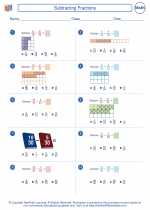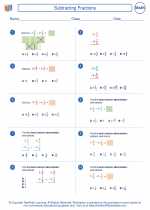Subtracting Fractions Study Guide
Subtracting fractions is a fundamental skill in math. When subtracting fractions, the key is to have a common denominator. Here's a step-by-step guide to help you understand and master subtracting fractions:
Step 1: Find a Common Denominator
In order to subtract fractions, they must have the same denominator. If the fractions you are working with have different denominators, you'll need to find a common denominator. This is the number that both denominators can evenly divide into.
Step 2: Adjust the Fractions
Once you have a common denominator, you can adjust the fractions by multiplying the numerator and denominator of each fraction by the same number so that they have the same denominator.
Step 3: Subtract the Numerators
After adjusting the fractions, you can subtract the numerators while keeping the denominator the same.
Step 4: Simplify (if necessary)
If the resulting fraction can be simplified, make sure to simplify it.
Example:
Let's subtract 3/4 - 1/4
Step 1: The denominators are the same, so no need to find a common denominator.
Step 2: Subtract the numerators: 3 - 1 = 2
Step 3: The result is 2/4
Step 4: Simplify. 2/4 simplifies to 1/2
So, 3/4 - 1/4 = 1/2
Now that you understand the steps, let's practice with some exercises!
.◂Math Worksheets and Study Guides Fifth Grade. Subtracting Fractions

 Worksheet/Answer key
Worksheet/Answer key
 Worksheet/Answer key
Worksheet/Answer key
 Worksheet/Answer key
Worksheet/Answer key
